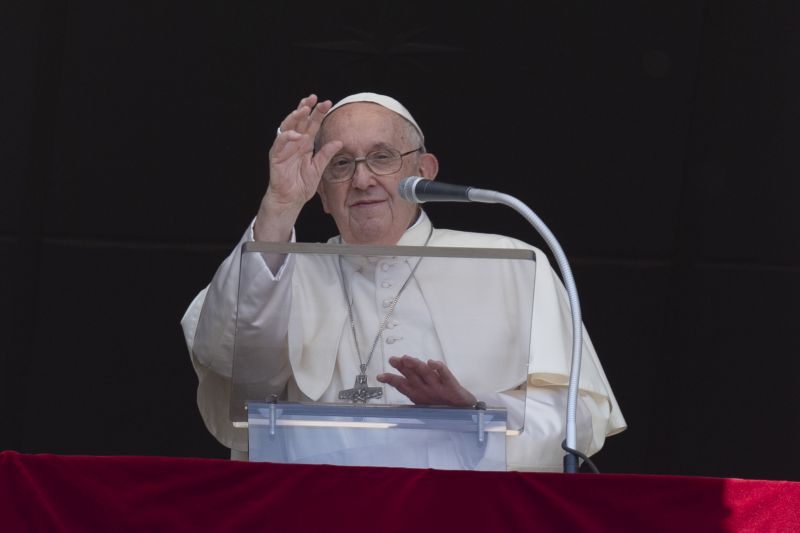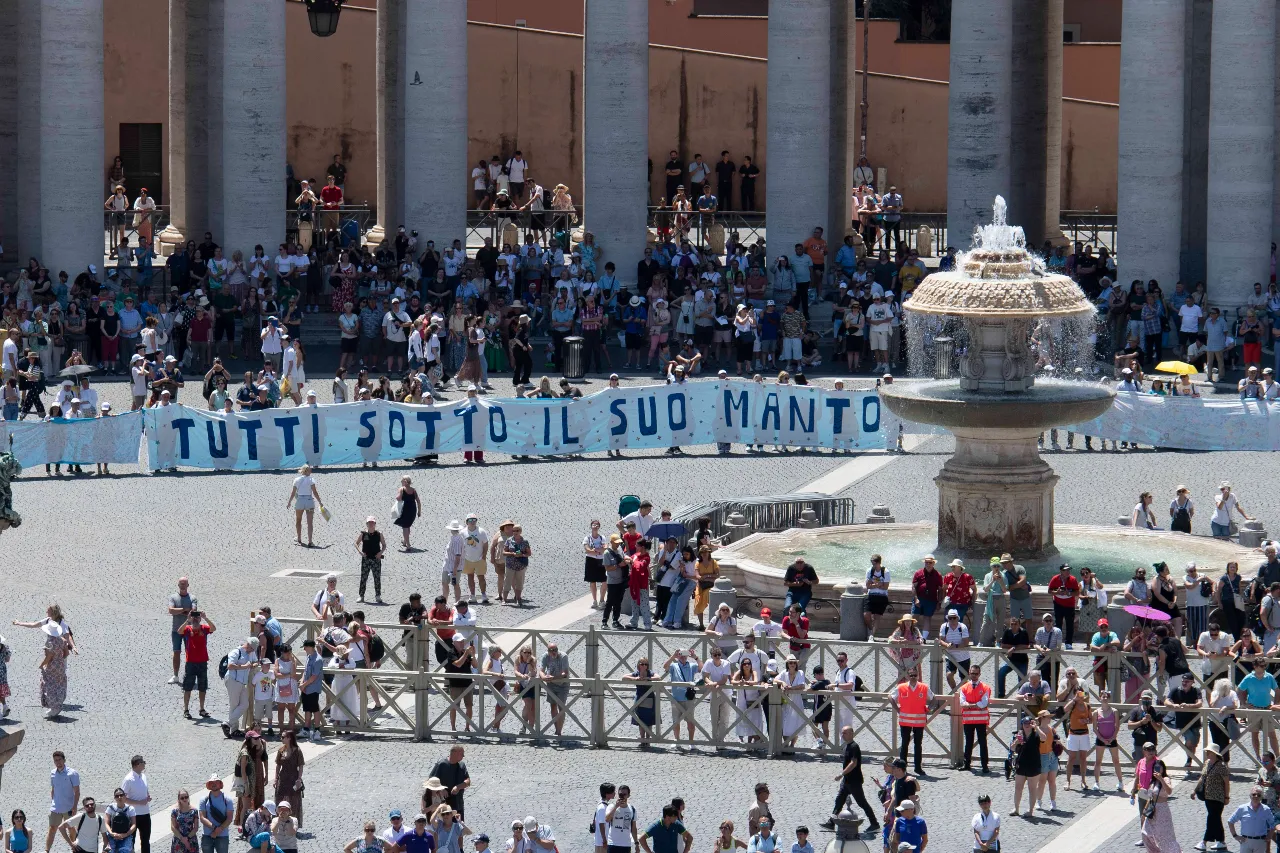
Vatican City, Jul 3, 2024 / 06:38 am (CNA).
The bishop of Lourdes said Tuesday that he personally believes that the Marian shrine’s mosaics by alleged abuser Father Marko Rupnik should be removed, but is holding off on making a final decision on the mosaics’ fate in the face of “strong opposition.”
Bishop Jean-Marc Micas of Tarbes and Lourdes issued a statement on July 2 explaining that more time is needed “to discern what should be done,” as his belief that Rupnik’s mosaics should be torn down “would not be sufficiently understood” and “would add even more division and violence” at this moment.
For now, as a “first step,” the French bishop has decided that Rupnik’s mosaics will no longer be lit up at night during the Lourdes’ nightly candlelight rosary processions with pilgrims.
The Lourdes bishop’s announcement comes less than two weeks after he met with Pope Francis in a private audience at the Vatican on June 20.
“For my part, my personal opinion is now clear … my personal opinion is that it would be preferable to remove these mosaics,” Micas said.
“This option is not widely accepted. It even meets with strong opposition on the part of some: the subject stirs up passions. Today the best decision to take is not yet ripe and my conviction-turned-decision, which would not be sufficiently understood, would add even more division and violence,” he added.
The bishop’s statement comes after more than a year of discernment and prayer. Micas formed a special commission in May 2023 to determine the future of the Rupnik mosaics made up of victims of abuse, sacred art specialists, lawyers, safeguarding experts, and chaplains.
Micas told CNA in an interview at the Lourdes’ shrine in February that he had received a “pile of letters” from Catholics all over the world regarding Rupnik’s mosaics.
“We’ve received letters, letters, a pile of letters — people very angry because the mosaics are still there and other people who were very angry at the idea we could remove them,” the bishop said.
“This [decision] occupies my mind, my prayer, and my heart every day, especially when I meet victims of abuse,” Micas added.
The Rupnik mosaics, added to the Sanctuary of Our Lady of Lourdes in 2008, depict the luminous mysteries of the rosary with the “Wedding Feast at Cana” in the center of the exterior entrance to the lower basilica. Rupnik’s wide-eyed figures are set against bright gold backdrops in marked contrast with the 19th-century shrine’s neo-Gothic stone facade.

Rupnik, a priest and artist, has been accused by about two dozen women, mostly former religious sisters, of spiritual, psychological, and sexual abuse over three decades.
He was removed from the Jesuits one year ago, and the Vatican has announced that Rupnik will face a canonical process over the abuse allegations after Pope Francis decided to waive the statute of limitations on the claims.
The priest’s prolific art career that followed his alleged abuse has created a problem for many shrines and Catholic churches across Europe and North America. Rupnik’s workshop has accounted for projects for more than 200 liturgical spaces around the world, including Fatima, the Vatican, the John Paul II shrine in Washington, D.C., and the tomb of St. Padre Pio.
Some have argued that removing Rupnik’s art would be a manifestation of “cancel culture” and point to the work of Renaissance artists with scandalous personal lives. Others highlight the allegations that the accused priest convinced religious sisters to commit sins with him by persuading them that sinful acts would worship God and ask if his sacred art might likewise be imbued with and communicate “a false Gospel.”
The Vatican has come under criticism as it has continued to publish images of mosaics made by Rupnik on its official media outlet, Vatican News, most recently on June 28. Paolo Ruffini, the head of the Vatican’s communications office, defended using Rupnik’s art during an appearance in Atlanta on June 21, arguing that removing it wouldn’t help his accusers.
Cardinal Seán O’Malley, the pope’s top adviser on clerical sexual abuse prevention, sent a letter to the Roman Curia on June 26 asking Vatican officials not to use Rupnik’s art to “avoid sending a message that the Holy See is oblivious to the psychological distress that so many are suffering.”
For Lourdes, the problem is felt acutely as the Marian shrine is known throughout the world as a place of healing and consolation and thought of by many as a privileged place for abuse victims seeking healing. The French bishops have underscored this by gathering in Lourdes to pray and fast for victims of abuse.
In his most recent statement, Micas underlined that he believes that at Lourdes the suffering and the wounded, including victims of sexual abuse, must always come first.
“My role is to ensure that the Sanctuary is welcoming to everyone, especially those who are suffering, including victims of sexual abuse and assault, both children and adults,” the bishop said.
“At Lourdes, the suffering and wounded in need of consolation and reparation must always be prioritized. This is the special grace of this shrine: nothing should prevent them from responding to Our Lady’s message to come here on pilgrimage.”
For this reason, Micas said that he believes that mosaics should be removed. He added that Rupnik’s art “has nothing to do with other artworks whose artists and victims are deceased, sometimes for centuries.”
“Here, the victims are alive and so is the artist,” he said.
Entrusting the situation to Our Lady of Lourdes and St. Bernadette, the bishop said that he will “continue to work even more with victims and to discern what should be done here in Lourdes to honor the absolute requirement of consolation and reparation.”
If you value the news and views Catholic World Report provides, please consider donating to support our efforts. Your contribution will help us continue to make CWR available to all readers worldwide for free, without a subscription. Thank you for your generosity!
Click here for more information on donating to CWR. Click here to sign up for our newsletter.







We read: “The Rupnik mosaics […] depict the luminous mysteries of the rosary with the “Wedding Feast at Cana”.
Wedding, what wedding?
Instead, was Rupnik fully in step with Cardinal Fernandez’s theology? That when Rupnik was predator to each nun, the event simply involved a binary “irregular couple,” and should not be canceled (a backwardist horror!). But, rather, “blessed” in perpetuity, if only artfully, “non-liturgically, spontaneously, and informally,” on the walls of chapels, cathedrals, and even Lourdes—where appeared the Immaculate Conception.
Thus, a sort of “equality” alongside Archbishop Paglia’s non-binary/homoerotic mural inside yet another cathedral and where, likewise, the cleric act-ually includes himself as a permanent part of the event, or picture, or whatever: https://www.lifesitenews.com/news/leading-vatican-archbishop-featured-in-homoerotic-painting-he-commissioned
“Violence for removing Rupnik-Abuser-Art?”
The “abuser-guild” will rise up and commit violence to defend their membership?